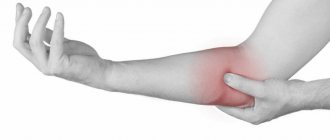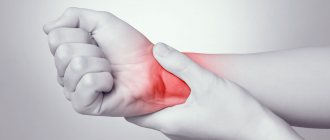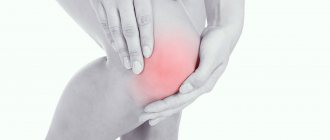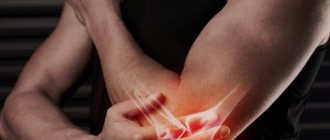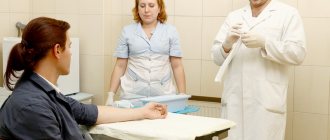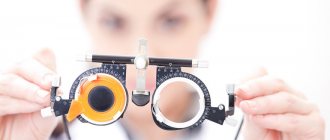Why do my joints hurt?
Joints can hurt for two reasons: arthritis, inflammation of joint tissue, or arthrosis (osteoarthrosis), a degenerative-dystrophic process, that is, destruction of the osteochondral elements of the joint.
The diagnosis must be made by a doctor, but you can navigate the symptoms yourself. Inflammation in arthritis is like a forest fire: everything starts violently, the joint swells and hurts very much even at rest, and when you try to make the slightest movement, the pain intensifies. The skin in this area turns red and feels hot to the touch.
With arthrosis, everything is different: the joints are destroyed slowly and unnoticeably at first. Pain in the joints, at first slight, aching, occurring only with movement, is quite tolerable, but grows over time, becoming constant and strong enough to disturb rest and sleep. The insidiousness of this pain is that it is delayed in relation to the pathological process that occurs in the joint, and occurs only when signs of destruction of the corresponding joint, unfortunately irreversible, become visible on X-ray photographs. This is the growth of spines (marginal osteophytes) along the edge of the articular surfaces of the bones that form the joint, narrowing of the joint space and signs of osteosclerosis - areas of pathological increase in bone density (Fig. 1). If arthrosis affects one joint, say the knee, the biomechanics change and the function of neighboring joints - the hip and ankle - is disrupted. They experience increased and uneven load and, as a result, wear out faster. Thus, arthrosis affects joint after joint, and the pain intensifies and can spread to all new joints.
Figure 1. Arthrosis of the knee joint (gonarthrosis). The cartilage is destroyed, the joint space is narrowed, and there are growths on the bone - osteophytes, which impede movement. Source: CC0 Public Domain
Why does it hurt
The ankle is the articulation of three bones - the fibula, tibia and talus. They are all connected to tendons. Around it there are many muscles responsible for flexing the sole. If mechanical or degenerative damage occurs in this structure, pain occurs.
Most often, the ankle joint hurts for the following reasons:
- ankle arthrosis;
- arthritis due to partial or complete dislocation;
- gout;
- tendinitis;
- tunnel syndrome;
- heel bone fracture;
- pathology of the anatomical structure of the joint.
People who lead a sedentary lifestyle are most susceptible to ankle diseases. Ligaments and muscles become flaccid, lose the ability to exercise, and therefore react to them with dislocations, sprains and fractures. Also at risk are people with increased body weight, flat feet, the elderly and athletes.
Arthrosis is not the only possible cause of pain in the ankle joint
Types of pain
The type and nature of pain depends on the cause that caused it.
Joints ache with the flu and acute respiratory infections against a background of high (up to 40 ⁰C) temperature. This pain goes away on its own as soon as the temperature returns to normal and does not require special treatment.
Arthritis pain:
- spicy,
- painful,
- pulsating,
- shooting,
- occurs at rest and intensifies when performing certain movements,
- sending out to neighboring areas,
- when palpated, it hurts everywhere, over the entire surface of the joint, but especially along the joint space.
Periarthritis is especially unbearable - inflammation of the tissues around the joint (its bursa, tendons and ligaments). How everything happens can be explained using the example of the shoulder joint (Fig. 2). First the joint begins to ache. The pain very quickly becomes excruciating, almost unbearable. It radiates to the shoulder blade and neck area, intensifies (and is often accompanied by a crunching sound) when trying to stretch your arms to the sides at shoulder level or bend them at the elbow and place them behind your back. There are pain points at the end of the collarbone, which rests on the shoulder joint in front, and in the same place at the back. When you press on them with your finger, the pain intensifies. With such acute sensations, the joint requires immobilization - you need to hang your hand on a scarf, try not to move it. This is an important condition for the success of treatment.
Figure 2. Humeroscapular periarthritis. Inflammation of the soft tissue around the joint causes severe pain, often causing disability. The prevalence of the disease is high and amounts to about 4-7% in the population. Photo: CC0 Public Domain
Important! quickly select adequate pain relief and anti-inflammatory therapy after the examination. This will reduce the severity of joint inflammation, reduce pain and improve the quality of life.
With arthrosis, joint pain is different:
- At first, the pain is not severe and intermittent, its character is wave-like - at certain periods it does not exist for weeks or even months. But over time, without treatment, the waves of pain become more severe and come more often, and the intervals between them become shorter.
- Pain at the start: it explodes during the first attempt to take a step, raise an arm, or bend over. Then the joints seem to develop, and the pain goes away.
- Mechanical rhythm - the joint begins to hurt when you load it. First, the pain appears during high loads - lifting heavy objects, running up the stairs, long walking, playing sports. Later, even minor movements echo with pain. But at the same time, unlike the discomfort of arthritis, the pain of arthrosis goes away when you give the joint a rest and provide it with peace. That's why doctors talk about a mechanical rhythm: movement provokes pain, and rest relieves it.
- Night discomfort. There is no pain at rest as such, but lying down is uncomfortable, I always want to change my position, to find a position in which I could forget about the joints and spine, but I can’t. My joints ache, that's all!
- The shackles of the morning: you woke up, there is no pain yet, but it’s as if you were shackled with a chain or tightly swaddled - your joints don’t obey, but little by little the feeling of stiffness goes away, the range of motion in the joint is restored.
- Protective posture. When a joint hurts, you want to take the so-called antalgic - anti-pain pose, in which it becomes easier. This is best seen in the example of the spine: it also consists of joints. When one of them jams, and along with it a nerve root gets caught in a bone vice, acute pain occurs due to radiculitis. Anyone suffering from radiculitis can be diagnosed by anyone who sees how the poor thing is twisted. In fact, with the help of this “distortion”, supported by muscle spasm, the body tries to reduce pain to a minimum.
Arthrosis of the hip and knee
Pain when the hip joint is affected (and it most often affects one side) is localized in the upper part of the thigh and radiates to the knee. He usually starts getting sick in the afternoon, when he has already worked quite a lot. The pain intensifies when walking, and at rest weakens and disappears.
Most often, both knee joints are affected at once. They bend easily, but begin to hurt when bent. Damage to the knees is characterized by the so-called staircase symptom. It becomes more painful to go down than to go up; patients do this by turning sideways. Sometimes a joint becomes jammed in a half-bent position due to a bone outgrowth (osteophyte) or its fragment (such a bone fragment “lost” inside the joint is called an “articular mouse”). Blockage of the joint is accompanied by increased pain when trying to bend or straighten it.
Knee mobility problems are not always due to arthritis. Sometimes joint jamming can be “false”. Some of the most common causes of knee pseudolock include:
- Swelling (excess fluid in the joint capsule can prevent full flexion and extension of the joint),
- Inflammation (inflammation of tissue in the knee, such as in rheumatoid arthritis and gout),
- Incorrect movement of the kneecap in the joint (accompanied by severe pain),
- Irritation of the tissue lining the joint
- Knee injury (any serious injury to the knee, such as a sprain, can cause muscle spasm).
Important! If the joint is jammed and active movements in the joint are impossible, it is necessary to seek medical help as soon as possible from an orthopedic traumatologist - to an emergency room, hospital clinic.
Do not hesitate to call an ambulance - this is a good reason to call it, because you won’t get far on one leg and you may not even get to the clinic yourself.
Treatment
Help before diagnosis
For aching joints associated with physical activity, special treatment is not required; a long rest with dosing of loads is sufficient. Unpleasant joint sensations that occur during pregnancy usually go away on their own after pregnancy or are corrected by controlling weight and taking vitamin and mineral supplements. Elderly and obese patients are advised to change their lifestyle: adequate physical activity, a diet of appropriate calorie content with a sufficient content of plant foods.
Aches in the bones, joints and muscles, combined with general malaise and fever, increased aching and pulling sensations to the point of severe pain, and the development of persistent pain are indications for consulting a doctor. To reduce joint discomfort caused by ARVI, it is recommended to rest, drink enough water, rosehip infusions, and dried fruits. Until serious diseases that provoke aching joints are excluded, self-medication with painkillers, long-term unsuccessful application of compresses, lotions, decoctions, etc. are unacceptable.
Conservative therapy
You can get rid of joint pain with the right treatment, aimed at eliminating the cause of the disorder and individual parts of the mechanism of its development. Etiopathogenetic therapy is usually supplemented with symptomatic medications that quickly reduce the severity of nagging and aching pain. The treatment regimen for diseases that occur with aching joints may include:
- Antimicrobials
. Basic therapy for infections is based on the prescription of antibiotics to which the pathogen is susceptible. In severe cases, broad-spectrum medications are used until the sensitivity of the microorganism is established. - Nonsteroidal anti-inflammatory drugs
. They reduce the production of inflammatory mediators and thereby inhibit inflammatory processes in the joints. By influencing central pain receptors, they reduce the degree of joint discomfort. Used in the form of tablets, ointments, gels. - Corticosteroids
. They have a strong anti-inflammatory effect. Hormonal therapy is the basis for the treatment of systemic collagenosis. In severe and resistant forms of the disease, corticosteroid drugs are combined with immunosuppressants to enhance the effect. - Chondroprotectors
. They act as a substrate for the synthesis of protein glycans, a sufficient amount of which increases the elasticity of articular cartilage. Nourishes cartilage tissue and restores its damaged structure. Intra-articular administration of drugs is possible. - Xanthine oxidase inhibitors
. Used as anti-gout drugs. They block the key enzyme necessary for the synthesis of uric acid, thereby reducing its concentration in the body and promoting the dissolution of existing urate deposits. - Vitamin-mineral complexes
. Recommended for the treatment of aching joints caused by metabolic disorders. The most commonly used drugs contain calcium and vitamin D. They are also an element of complex therapy for inflammatory and metabolic diseases. - Chemotherapeutic agents
. They serve as the basis for most treatment regimens for various types of oncohematological pathologies. Depending on the clinical variant and severity of the neoprocess, they are combined with radiotherapy and surgical interventions.
Diagnostics
Based on the nature of the pain and the appearance of the affected joint, even a non-specialist can make a preliminary diagnosis (arthritis or arthrosis). But hurry to your local clinic to confirm your assumptions!
A doctor examines a patient's sore knee. Photo: chayanuphol/freepik.com
Which doctor should I contact?
If you have joint pain, you should make an appointment with your local physician. He performs the functions of a medical dispatcher: he records complaints and clinical symptoms, refers the patient for examination and, based on its results, decides which doctor should be consulted for each specific patient. A variety of specialists are involved in maintaining joint health:
- arthrologist,
- traumatologist-orthopedist,
- rheumatologist,
- vertebrologist (if the spinal joints are affected),
- podiatrist (if we are talking about foot joints),
- surgeon,
- oncologist,
- neurologist (if the joint has already been treated, but the pain remains),
- nutritionist (if your joints hurt due to metabolic disorders, such as gout, or if you are overweight).
What tests and research should I do?
The examination begins with the simplest - a clinical (finger) and biochemical (from a vein) blood test for signs of inflammation, as well as a general urine test. In some joint diseases, the kidneys are involved in the pathological process. Excess uric acid salts in the urine may indicate gout as a cause of joint disease.
Laboratory examination of the synovial fluid located inside the joint helps to detect the inflammatory process and clarify its nature. It is obtained by puncturing the joint capsule - puncture. If necessary, a histological examination of a fragment of the synovial membrane lining the joint cavity from the inside is performed.
A proven diagnostic method is radiography of the joint in two standard projections. It will help visualize narrowing of the joint space, bone spurs, osteoporosis and osteosclerosis (areas of low and high bone density, Fig. 3).
Figure 3. X-ray of the right wrist. Development of osteoporosis (b, c) during treatment with human monoclonal antibodies. Arrows indicate two-layer sclerotic stripes after two courses of the drug. Source: Elsevier Ltd/The Lancet
Currently, magnetic resonance imaging provides comprehensive information about the condition of the joint.
Arthrosis and arthritis: symptoms, treatment and prevention
Osteoarthritis and arthritis, although they have similar symptoms that are accompanied by damage to the joints, are different diseases. In the first case, destruction of articular cartilage and deformation of bone tissue occurs. The main indicators of the development of arthrosis (osteoarthrosis) are mechanical and biological processes. It most often appears in the arms (fingers), neck, lower back, knees and hips.
Arthritis is a collective term that refers to diseases of the joints of inflammatory etiology. Most commonly manifest as osteoarthritis (a degenerative disease) and rheumatoid arthritis. The disease is considered the most common cause of disability.
What joint diseases can cause pain?
There are more than a hundred such diseases. In the elderly, arthrosis is widespread, and in the young, rheumatoid arthritis and injuries (bruises, fractures, ligament damage) are widespread.
“Together with arterial hypertension, which is commonly called hypertension, joint diseases lead the list of the most common reasons for seeking medical help. And the chronic pain that patients experience and because of which they cannot fully live and work is not only a medical, but also an important social problem,” says Doctor of Medical Sciences, Professor of the Department of Rheumatology of the Russian Medical Academy of Continuing Professional Education, senior lecturer educational department of the Research Institute of Rheumatology named after. V.A. Nasonova Natalya Vladimirovna Chichasova. – Of all joint diseases, arthrosis is the most common. 97% of those over 65 years old suffer from this disease. And if we talk about chronic inflammatory diseases of the joints - arthritis, rheumatoid arthritis comes to the fore. It is also not a gift, and not only because of the pain syndrome: already 3-5 years after its onset, this type of arthritis inevitably ends with the patient being assigned a disability group.”
How to quickly help yourself in case of an ankle injury
If you feel severe pain in your foot due to injury or severe mechanical stress, do the following:
- place your foot on a small hill;
- remain in this position until the pain becomes less intense;
- apply a cold compress of ice wrapped in thick cloth for 20 minutes;
- eliminate the load on the leg, swaddle the injured foot tightly with a bandage (relevant during the first two days);
- As soon as possible, go to the doctor.
A cold compress of ice helps in the first hours after injury
How to get rid of joint pain urgently?
Pills.
Photo: Bloack / Depositphotos Analgesics can quickly overcome pain: you should not tolerate pain under any circumstances if you do not want it to turn from acute to chronic. This metamorphosis can happen very quickly - in 3-4 weeks, so getting rid of joint pain should be an immediate priority. The joint starts to hurt as soon as you put stress on it. Therefore, in case of pain, half an hour before any physical activity, you should take a non-steroidal anti-inflammatory drug (NSAID) with a good analgesic effect.
If joint pain intensifies at night, in addition, before going to bed, the doctor will recommend taking metamizole sodium, as well as drotaverine with nicotinic acid to improve local blood circulation.
Local therapy
NSAIDs have a dangerous side effect - they can cause damage to the gastric mucosa, even leading to the formation of ulcers, so they try to use them topically, as part of various ointments and gels with anti-inflammatory and analgesic properties. They are usually rubbed into the skin over the affected joint twice a day. Special patches with magnetic powder, which are glued to a joint or area of the spine, also relieve pain.
Self-help during attacks of gout, arthritis and synovitis
Take a pain reliever or use an ointment with an analgesic and anti-inflammatory effect. Secure the joint with an elastic bandage, try to move as little as possible, and use support when walking. Avoid eating fatty, spicy, salty and spicy foods.
If you have already been diagnosed with one or another, you can take medications previously prescribed by your doctor to eliminate the cause of the pain attack. For example, during an exacerbation of gout, it is necessary to take medications that help remove excess purines from the body. If you have a high temperature and very severe pain, call an ambulance.
Classification of foot diseases and types of arthrosis
There are dozens of small joints in the foot. The problem can start in any of them. In modern medicine, there are different types of arthrosis of the foot, which are distinguished by its location. The disease can develop in:
- subtalar ligament;
- cuboid-calcaneal joint;
- metatarsophalangeal joint;
- arthrosis of the toe.
Arthrosis of the foot is also divided by degree. There are the following types:
- Primary.
May occur due to pathology in the foot or after injury or damage;
- Secondary.
Arthrosis of the foot of this degree appears due to diseases that affect the lower extremities. This could be hormonal disorders or any other;
- Polyarthrosis.
This is a complex degree of arthrosis of the foot. The disease affects not one, but several or more joints at once.
Treatment is prescribed depending on what type of arthrosis affects the foot.

